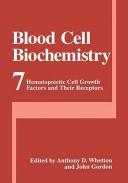| Listing 1 - 10 of 10 |
Sort by
|
Book
Year: 2005 Publisher: Bruxelles: UCL,
Abstract | Keywords | Export | Availability | Bookmark
 Loading...
Loading...Choose an application
- Reference Manager
- EndNote
- RefWorks (Direct export to RefWorks)
Dissertation
Year: 2001 Publisher: Rotterdam Optima
Abstract | Keywords | Export | Availability | Bookmark
 Loading...
Loading...Choose an application
- Reference Manager
- EndNote
- RefWorks (Direct export to RefWorks)
Endothelial Growth Factors --- Lymphokines --- Osteoblasts --- Receptors, Growth Factor --- biosynthesis --- biosynthesis --- physiology --- biosynthesis

ISBN: 0897669517 0897669525 9780897669511 9780897669528 Year: 1995 Volume: 766 Publisher: New York (N.Y.) New York academy of sciences
Abstract | Keywords | Export | Availability | Bookmark
 Loading...
Loading...Choose an application
- Reference Manager
- EndNote
- RefWorks (Direct export to RefWorks)
Signal Transduction --- Receptors, Growth Factor --- Receptors, Immunologic --- Cellular signal transduction --- Cell receptors --- Hormone receptors --- Growth factors --- Antigen recognition --- physiology --- Congresses --- Receptors --- -Cell receptors --- -Cellular signal transduction --- -Growth factors --- -Hormone receptors --- -#ABIB:aimm --- #ABIB:aeco --- 577.35 --- Hormones --- Receptors, Hormone --- Cell growth factors --- Cellular growth factors --- Growth peptides --- Growth promoting substances --- Growth substances --- Peptide growth factors --- Peptide regulatory factors --- Polypeptide growth factors --- Cytokines --- Peptides --- Cellular information transduction --- Information transduction, Cellular --- Signal transduction, Cellular --- Bioenergetics --- Cellular control mechanisms --- Information theory in biology --- Cell membrane receptors --- Cell surface receptors --- Receptors, Cell --- Binding sites (Biochemistry) --- Cell membranes --- Proteins --- Immunorecognition --- Recognition, Immune --- Immune response --- Immunospecificity --- -Congresses --- Biophysics of living systems --- Receptors, Growth Factor. --- Receptors, Immunologic. --- Congresses. --- physiology. --- 577.35 Biophysics of living systems --- #ABIB:aimm --- Receptors&delete& --- Antigen recognition - Congresses. --- Physiology. --- Signal Transduction - physiology --- Cellular signal transduction - Congresses --- Cell receptors - Congresses --- Hormone receptors - Congresses --- Growth factors - Receptors - Congresses --- Antigen recognition - Congresses --- SIGNAL TRANSDUCTION --- RECEPTORS, IMMUNOLOGIC --- RECEPTORS, GROWTH FACTOR --- PHYSIOLOGY

ISSN: 10780491 ISBN: 9780306452383 0306452383 9780585317281 1475770529 0585317283 Volume: v. 7 Publisher: New York, NY.
Abstract | Keywords | Export | Availability | Bookmark
 Loading...
Loading...Choose an application
- Reference Manager
- EndNote
- RefWorks (Direct export to RefWorks)
Historically, the field of hematopoietic growth factor research began with the work of Carnot and Deflandre-in 1906 they suggested that the rate of erythropoiesis is regulated by a humoral factor found in the blood, namely, erythropoietin. From this comparatively early start, accelerating progress has been made in erythropoietin research, which demon strates the general trends in this field of study. Erythropoietin was purified to homogeneity by 1977 (from enormous quantities of urine from aplastic anemia patients). Subsequently, the gene for erythropoietin has been cloned (1985), and massive quantities of this growth factor have been produced for clinical trials (late 1980s onward). Erythropoietin has become established as a pharmaceutical product of great value in the treatment of a number of diseases, most notably chronic renal failure. Once the ligand had been cloned, interest turned to the erythropoietin receptor, which was cloned in 1989. Since then, structure/ function studies have been performed on receptor mutants, cellular signaling events down stream from the occupied receptor have been identified, and the specific producer cell types and molecular stimuli for erythropoietin production have been thoroughly investigated, as has the regulation of erythropoietin gene transcription. This schedule of events since the 1970s typifies that seen for a number of hematopoietic growth factors. Along the way, the hematopoietic growth factors have been recognized as members of the cytokine family of signaling molecules that are important in a number of different physiological and patholog ical situations (see below).
Hematopoietic Cell Growth Factors --- Receptors, Growth Factor --- Blood Cells --- Erythropoietin --- Blood cells --- Hematopoietic growth factors. --- Erythropoïétine --- physiology. --- therapeutic use. --- immunology. --- immunology --- Biochemistry. --- Cell Biology. --- 57 --- Cellular Biology --- Cytology --- Biologies, Cell --- Biologies, Cellular --- Biology, Cell --- Biology, Cellular --- Cell Biologies --- Cellular Biologies --- Biological sciences in general --- Periodicals --- Health Sciences --- Physiology --- Biochemistry --- Cell Biology --- Oncology . --- Hematology. --- Immunology. --- Human genetics. --- Oncology. --- Biochemistry, general. --- Human Genetics. --- Blood cells.
Book
ISBN: 9781597453561 1588299481 9781588299482 9786612036330 1597453560 1282036335 Year: 2008 Publisher: New York, NY : Humana Press,
Abstract | Keywords | Export | Availability | Bookmark
 Loading...
Loading...Choose an application
- Reference Manager
- EndNote
- RefWorks (Direct export to RefWorks)
The epidermal growth factor (EGF) receptor and its downstream signal transduction networks have been implicated in the ontology and maintenance of tumor tissues, which has motivated the discovery and development of molecularly targeted anti-EGFR therapies. Edited by John Haley and William J. Gullick, EGFR Signaling Networks in Cancer Therapy, is separated into two sections. The first of which probes the molecular pathways and the intersection of signaling networks which are frequently deregulated in human cancers, with a view to describing EGF receptor in a tumor tissue specific context. Meanwhile, the second section illustrates the many ways in which EGF receptor contribute to abnormal survival and migration signaling in cancer cells and to epithelial to mesenchymal transition and metastasis. The book also describes the mitogenic, survival, adhesive and migratory pathways within a framework of interacting subsystems that contribute to the activity and physiological regulation of the receptor in normal and neoplastic tissues. Even though there is still much to learn, this volume explores this fascinating system with compelling information.
Medicine & Public Health. --- Oncology. --- Cancer Research. --- Medicine. --- Médecine --- Cancérologie --- Cancer --Chemotherapy. --- Cancer --Treatment. --- Cancer --- Receptors, Gastrointestinal Hormone --- Receptor Protein-Tyrosine Kinases --- Cell Physiological Processes --- Diseases --- Receptors, Growth Factor --- Biochemical Processes --- Receptors, Cell Surface --- Cell Physiological Phenomena --- Biochemical Phenomena --- Receptors, Peptide --- Protein-Tyrosine Kinases --- Chemical Processes --- Chemical Phenomena --- Membrane Proteins --- Phenomena and Processes --- Protein Kinases --- Phosphotransferases (Alcohol Group Acceptor) --- Proteins --- Amino Acids, Peptides, and Proteins --- Phosphotransferases --- Chemicals and Drugs --- Transferases --- Enzymes --- Enzymes and Coenzymes --- Receptor, Epidermal Growth Factor --- Signal Transduction --- Neoplasms --- Medicine --- Health & Biological Sciences --- Oncology --- Treatment --- Chemotherapy --- Chemotherapy. --- Treatment. --- Cancer therapy --- Cancer treatment --- Therapy --- Cancer research. --- Tumors --- Cancer research --- Clinical sciences --- Medical profession --- Human biology --- Life sciences --- Medical sciences --- Pathology --- Physicians --- Antineoplastic agents

ISBN: 1280968265 9786610968268 0080472583 0121602818 9780121602819 9780080472584 9781280968266 6610968268 Year: 2004 Publisher: Amsterdam Boston Elsevier Academic Press
Abstract | Keywords | Export | Availability | Bookmark
 Loading...
Loading...Choose an application
- Reference Manager
- EndNote
- RefWorks (Direct export to RefWorks)
The enormity of the literature on growth factors, plus the breadth of the biological disciplines and technical expertise required prohibits a comprehensive review by even a multi-disciplinary panel of authors. To provide an alternative that is feasible for authors and digestible by readers, this review compendium consists of a collection of articles, each covering an aspect of teh ErbB/EGF field. This compilation features articles on growth factor ligands, neuregulins, and individual receptors. The second part of the book concentrates on the biological context of the ErbB receptors, particular
Epidermal growth factor. --- Neoplasms. --- Receptor, Epidermal Growth Factor. --- Tumors. --- Receptors, Growth Factor --- Diseases --- Receptor Protein-Tyrosine Kinases --- Receptors, Gastrointestinal Hormone --- Protein-Tyrosine Kinases --- Receptors, Peptide --- Receptors, Cell Surface --- Protein Kinases --- Membrane Proteins --- Proteins --- Phosphotransferases (Alcohol Group Acceptor) --- Phosphotransferases --- Amino Acids, Peptides, and Proteins --- Chemicals and Drugs --- Transferases --- Enzymes --- Enzymes and Coenzymes --- Receptor, Epidermal Growth Factor --- Neoplasms --- Medicine --- Health & Biological Sciences --- Oncology --- Tumors --- Epidermal growth factor --- Growth. --- Receptors. --- Anthelone --- EGF (Growth factor) --- EGF-URO (Growth factor) --- EGF-Urogastrone --- Epidermal growth factor-Urogastrone --- Uroanthelone --- Uroenterone --- Cancer --- Neoplasm growth --- Tumor growth --- Growth --- Growth factors
Book
ISBN: 1461408865 9786613696793 128078640X 1461408873 Year: 2012 Publisher: New York : Austin, Tex. : Springer Science+Business Media ; Landes Bioscience,
Abstract | Keywords | Export | Availability | Bookmark
 Loading...
Loading...Choose an application
- Reference Manager
- EndNote
- RefWorks (Direct export to RefWorks)
"Fibroblast growth factors (FGFs) have been recognized primarily as autocrine/paracrine factors that regulate embryonic development and organogenesis. However, recent studies have revealed that some FGFs function as endocrine factors and regulate various metabolic processes in adulthood. Such FGFs, collectively called endocrine FGFs, are comprised of three members (FGF15/19, FGF21, and FGF23: FGF15 is the mouse ortholog of human FGF19). These endocrine FGFs share a common structural feature that enables the endocrine mode of action at the expense of the affinity to FGF receptors. To restore the affinity to FGF receptors in their target organs, the endocrine FGFs have designated the Klotho family of transmembrane proteins as obligate co-receptors. By expressing Klothos in a tissue-specific manner, this unique co-receptor system also enables the endocrine FGFs to specify their target organs among many tissues that express FGF receptors"--Provided by publisher.
Endocrine toxicology. --- Fibroblast growth factors. --- Protein binding. --- Receptors, Growth Factor --- Anatomy --- Glycoside Hydrolases --- Intercellular Signaling Peptides and Proteins --- Metabolic Phenomena --- Peptides --- Proteins --- Receptors, Peptide --- Biological Factors --- Hydrolases --- Phenomena and Processes --- Enzymes --- Amino Acids, Peptides, and Proteins --- Receptors, Cell Surface --- Chemicals and Drugs --- Membrane Proteins --- Enzymes and Coenzymes --- Metabolism --- Receptors, Fibroblast Growth Factor --- Fibroblast Growth Factors --- Endocrine System --- Glucuronidase --- Biology --- Human Anatomy & Physiology --- Health & Biological Sciences --- Cytology --- Animal Biochemistry --- Fibroblast growth factors --- Endocrinology. --- Endocrine aspects. --- Metabolism. --- Fibroblast growth factor --- Life sciences. --- Gene expression. --- Cell biology. --- Life Sciences. --- Cell Biology. --- Gene Expression. --- Cell biology --- Cellular biology --- Cells --- Cytologists --- Genes --- Genetic regulation --- Biosciences --- Sciences, Life --- Science --- Expression --- Growth factors --- Mitogens --- Internal medicine --- Hormones --- Cytology.
Book
ISBN: 1615040455 1615040463 Year: 2010 Publisher: San Rafael, Calif. (1537 Fourth Street, San Rafael, CA 94901 USA) : Morgan & Claypool,
Abstract | Keywords | Export | Availability | Bookmark
 Loading...
Loading...Choose an application
- Reference Manager
- EndNote
- RefWorks (Direct export to RefWorks)
The placenta is an organ that connects the developing fetus to the uterine wall, thereby allowing nutrient uptake, waste elimination, and gas exchange via the mother's blood supply. Proper vascular development in the placenta is fundamental to ensuring a healthy fetus and successful pregnancy. This book provides an up-to-date summary and synthesis of knowledge regarding placental vascular biology and discusses the relevance of this vascular bed to the functions of the human placenta.
Fetal stem cells -- Physiology. --- Placental circulation -- Physiology. --- Trophoblasts -- Physiology. --- Blastocyst --- Stem Cells --- Placenta --- Receptor Protein-Tyrosine Kinases --- Blood Circulation --- Endocrine Cells --- Receptors, Growth Factor --- Embryonic Structures --- Protein-Tyrosine Kinases --- Cells --- Embryo, Mammalian --- Receptors, Cell Surface --- Receptors, Peptide --- Cardiovascular Physiological Processes --- Anatomy --- Membrane Proteins --- Protein Kinases --- Cardiovascular Physiological Phenomena --- Proteins --- Circulatory and Respiratory Physiological Phenomena --- Phosphotransferases (Alcohol Group Acceptor) --- Fetal Stem Cells --- Trophoblasts --- Receptors, Vascular Endothelial Growth Factor --- Placental Circulation --- Phosphotransferases --- Amino Acids, Peptides, and Proteins --- Phenomena and Processes --- Transferases --- Chemicals and Drugs --- Enzymes --- Enzymes and Coenzymes --- Human Anatomy & Physiology --- Zoology --- Health & Biological Sciences --- Physiology --- Animal Anatomy & Embryology --- Blood-vessels. --- blood supply. --- placenta circulation --- trophoblast --- angiogenesis --- vasoactivity --- placental stem cells
Book
ISBN: 1283171325 9786613171320 0123878209 0123878195 9780123878205 9780123878199 6613171328 Year: 2011 Publisher: London ; Waltham, Mass. : Elsevier,
Abstract | Keywords | Export | Availability | Bookmark
 Loading...
Loading...Choose an application
- Reference Manager
- EndNote
- RefWorks (Direct export to RefWorks)
Recent years have seen a considerable emphasis on growth factors and the elucidation of their mode of function, which has led to the recognition that growth factors, their receptors as well as downstream elements of signalling associated with their function might be potential targets in therapeutic management of human diseases. Humanised monoclonal antibodies raised against growth factor receptors have proved to be valuable for targeted cancer treatment and in patient management. This book reviews the latest developments providing insights into the signalling processes involved in mo
Cancer -- Cytopathology. --- Cancer -- Molecular aspects. --- Cancer - Treatment. --- Cancer -- Treatment -- Data processing. --- Cell differentiation. --- Cell Differentiation. --- Cells - Growth. --- Cellular therapy. --- Drug targeting. --- Growth factors - Therapeutic use. --- Intercellular Signaling Peptides and Proteins - metabolism. --- Metastasis. --- Neoplasms - etiology. --- Neoplasms - therapy. --- Growth factors --- Cancer --- Cellular therapy --- Cell differentiation --- Cells --- Metastasis --- Biological Factors --- Peptides --- Cell Physiological Processes --- Metabolic Phenomena --- Proteins --- Diseases --- Receptors, Peptide --- Amino Acids, Peptides, and Proteins --- Cell Physiological Phenomena --- Phenomena and Processes --- Chemicals and Drugs --- Receptors, Cell Surface --- Membrane Proteins --- Intercellular Signaling Peptides and Proteins --- Neoplasms --- Cell Differentiation --- Receptors, Growth Factor --- Metabolism --- Medicine --- Human Anatomy & Physiology --- Health & Biological Sciences --- Animal Biochemistry --- Oncology --- Therapeutic use --- Treatment --- Growth --- Cell receptors --- Physiological effect. --- Treatment. --- Motility. --- Cell motility --- Cell movement --- Cellular movement --- Motility of cells --- Biomechanics --- Cell physiology --- Cancer therapy --- Cancer treatment --- Cell membrane receptors --- Cell surface receptors --- Receptors, Cell --- Binding sites (Biochemistry) --- Cell membranes --- Cell fate specification --- Cell specification --- Differentiation of cells --- Fate specification of cells --- Specification of cells --- Morphogenesis --- Movement --- Therapy --- Differentiation --- Fate specification --- Specification
Book
ISBN: 303480217X 3034808046 9786613573001 1280395087 3034802188 Year: 2012 Publisher: Basel, Switzerland : Springer,
Abstract | Keywords | Export | Availability | Bookmark
 Loading...
Loading...Choose an application
- Reference Manager
- EndNote
- RefWorks (Direct export to RefWorks)
Granulocyte colony-stimulating factor (G-CSF or GCSF) is a secreted glycoprotein that stimulates the proliferation and differentiation of granulocyte precursor cells, and induces mobilization of peripheral blood progenitor cells from the bone marrow. Development of recombinant human G-CSF has had a profound impact on the treatment of many diseases, including severe chronic neutropenia and cancer, and has enabled peripheral stem cell transplantation to supplant bone marrow transplantation in the autologous setting. This Milestones in Drug Therapy volume describes the experience of the last 20 years of treatment with recombinant human G-CSF, including the basic science, the use of recombinant human G-CSF in both the oncology and nononcology settings, and the safety and economics of its use. Many of the authors were the original investigators of recombinant human G-CSF and other authors are key researchers who provide their outlook for the next 20 years for use of and research with recombinant human G-CSF.
Drug abuse -- Etiology -- Handbooks, manuals, etc. --- Drug abuse -- Psychological aspects -- Handbooks, manuals, etc. --- Filgrastim --- Colony-Stimulating Factors --- Leukemia --- Neoplasms, Plasma Cell --- Receptors, Colony-Stimulating Factor --- Lymphoproliferative Disorders --- Hematologic Diseases --- Hemostatic Disorders --- Therapeutics --- Paraproteinemias --- Hemorrhagic Disorders --- Hematopoietic Cell Growth Factors --- Receptors, Cytokine --- Immunoproliferative Disorders --- Neoplasms by Histologic Type --- Analytical, Diagnostic and Therapeutic Techniques and Equipment --- Receptors, Growth Factor --- Hemic and Lymphatic Diseases --- Blood Protein Disorders --- Glycoproteins --- Vascular Diseases --- Cytokines --- Proteins --- Receptors, Peptide --- Neoplasms --- Receptors, Immunologic --- Diseases --- Immune System Diseases --- Cardiovascular Diseases --- Receptors, Cell Surface --- Amino Acids, Peptides, and Proteins --- Intercellular Signaling Peptides and Proteins --- Membrane Proteins --- Chemicals and Drugs --- Biological Factors --- Peptides --- Multiple Myeloma --- Granulocyte Colony-Stimulating Factor --- Drug Therapy --- Leukocyte Disorders --- Leukemia, Myeloid --- Receptors, Granulocyte Colony-Stimulating Factor --- Health & Biological Sciences --- Biology --- Pharmacy, Therapeutics, & Pharmacology --- Microbiology & Immunology --- Granulocyte-macrophage colony-stimulating factor. --- Colony-stimulating factors (Physiology) --- Granulocytes. --- Macrophages. --- Histiocytes --- Mononuclear phagocytes --- Granular leucocytes --- CSF-GM (Colony-stimulating factor) --- GM-CSF (Colony-stimulating factor) --- Histamine-producing cell-stimulating factor --- Medicine. --- Cancer research. --- Immunology. --- Pharmacology. --- Hematology. --- Cytokines. --- Growth factors. --- Biomedicine. --- Pharmacology/Toxicology. --- Cancer Research. --- Cytokines and Growth Factors. --- Antigen presenting cells --- Connective tissue cells --- Killer cells --- Phagocytes --- Reticulo-endothelial system --- Leucocytes --- Hematopoietic growth factors --- Toxicology. --- Oncology. --- Haematology --- Internal medicine --- Blood --- Cellular immunity --- Immune response --- Immunobiology --- Life sciences --- Serology --- Tumors --- Chemicals --- Medicine --- Pharmacology --- Poisoning --- Poisons --- Regulation --- Toxicology --- Cell growth factors --- Cellular growth factors --- Growth peptides --- Growth promoting substances --- Growth substances --- Peptide growth factors --- Peptide regulatory factors --- Polypeptide growth factors --- Cancer research --- Drug effects --- Medical pharmacology --- Medical sciences --- Chemotherapy --- Drugs --- Pharmacy --- Physiological effect
| Listing 1 - 10 of 10 |
Sort by
|

 Search
Search Feedback
Feedback About UniCat
About UniCat  Help
Help News
News